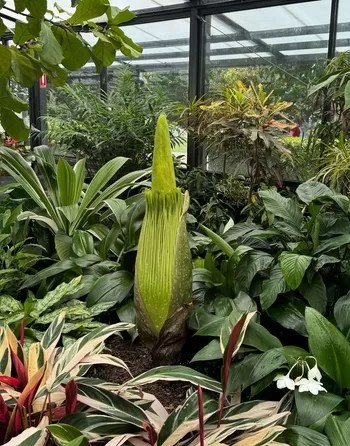A Once-in-a-Decade Chance to Witness Titan Arum’s Stunning and Stinky Display
The Titan Arum, or corpse flower, is nature’s dark-hearted gift to the patient and the macabre. If you’re lucky enough to stumble upon it in bloom, you’ll be struck not by its beauty but by a pungent, inescapable scent—like a million old eggs rotting in a bog.

This isn’t the sweet symphony of roses; it’s a raw, unapologetic spectacle, nature’s way of saying, “Not everything in life is supposed to smell pretty.”
If you’re anywhere near the Geelong Botanic Gardens, now’s the time to pay a visit—not for a typical walk through lilies and roses, but for something far more raw and primal.
The Titan Arum, known as the corpse flower, has started to blush, signaling its imminent, short-lived bloom.
This is no gentle floral awakening. When this beast opens, it brings with it the smell of decay—a bold, unapologetic stench that’s half horror show, half botanical miracle.
This isn’t some seasonal bloom. It’s a rare, unpredictable spectacle that could wait ten years to grace you with its deathly perfume. When it does, it’s a swift show—24 to 48 hours max. That’s all you get.
The clock is ticking, and between Tuesday, November 5, and Sunday, November 10, it’s likely to happen. You won’t want to miss it, but you may want to hold your breath.
The gardens are keeping their doors open longer than usual so you can see (and smell) this fleeting phenomenon. Can’t make it in person? The brave can follow the bloom’s progress, or dare to watch the live stream, on their Corpse Plant in Bloom page.
Get ready for a plant experience like no other—visceral, unforgettable, and utterly alive in its own strange way.
Advertisement:
What is the Corpse Flower?
Native to the steamy rainforests of Sumatra, the corpse flower is the rockstar of the botanical world, known to attract lines of people who travel from miles around just to get a whiff. And they aren’t disappointed. You wait for this bloom—years of waiting, like some cruel, seductive tease.
But then, in a swift 48 hours, the Titan Arum comes alive, towering at up to 10 feet, with its deep, burgundy petals flaring open around a central spadix. In this fleeting moment, the plant unleashes its weaponized stench, mimicking the smell of decaying flesh to attract its own audience: flesh flies and carrion beetles.

This isn’t your typical blooming plant, carefully cultivated and bred for fragrance and color. No, the Titan Arum is here to offend, to repel.
It’s designed to lure insects that thrive on the things most of us avoid, making it a rebel and a survivor in a world full of delicate blooms.
It doesn’t care about charming anyone; it’s on its own clock, with its own brutal method of luring in what it needs.
In its homeland, the Titan Arum is becoming as rare as a loyal friend, thanks to deforestation and the slow erosion of its habitat.
But even in captivity, growing one is a labor of love. Botanic gardens worldwide invest years, even decades, into coaxing a single bloom, providing visitors a short-lived, visceral experience.
Here’s a plant that makes you think twice about beauty and ugliness, about what life is really about. It’s the existential dare we sometimes need: are you brave enough to breathe it in, to face something you’d usually avoid?
Standing next to one, you realize nature isn’t about pleasing us. It’s about survival in its rawest, most unapologetic form. The Titan Arum doesn’t bloom for our pleasure; it blooms because that’s what it’s built to do.
In that, it’s almost a reminder—there’s beauty in the things we don’t understand, and even more in those we may never truly appreciate. The corpse flower invites you to question everything you thought you knew about beauty, fragrance, and life itself. Take a breath, if you dare.
Related stories
The Best Bee-Friendly Plants for Your Garden
Vegetarian Book Review: The Yearlong Pantry by Erin Alderson
Farming Innovation Reduces Use of Herbicides and Pesticides
Nesting Boxes: Creative Upcycling for Wildlife Conservation
Lunar Agriculture: Plants to be Grown on the Moon
Advertisement:




